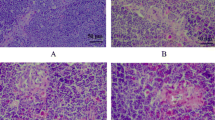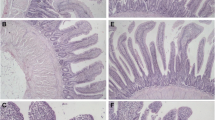Abstract
Selenium is an essential element with antioxidant roles in immune regulation, but there is little understanding of how Se acts in apoptosis in the immune organs of birds. The aim of study was to evaluate the influence of Se deficiency on oxygen free radicals, NO and apoptosis in immune organ of chickens. 160 1-day-old chickens were randomly assigned to two groups of 80 each and were fed on a low-Se diet (0.032 mg/kg Se) or a control diet (0.282 mg/kg Se), respectively. OFR production in blood was determined on days 30, 45, 60 and 75, respectively. The iNOS–NO system activity in immune organ (thymus, spleen, bursa of fabricius) was identified by NO content and NOS activity assay on days 30, 45, 60 and 75, respectively. Apoptosis was measured by DNA ladder analysis, ultrastructural observations, TdT-mediated dUTP nick end labeling TUNEL assay and flow cytometric analysis of apoptotic DNA. The transcription of factor-associated suicide, caspase-3 mRNA was tested by fluorescence quantitative PCR. The results showed that OFR production, NO and inducible NO synthases (iNOS) activity in the low-Se group were significantly increased (p < 0.05) than in the control group. In addition, apoptosis was observed in chicken immune organ in the low-Se group. The degree and the number of apoptotic cells rose in a time-dependent manner. The expression of Fas and caspase-3 mRNA increased (p < 0.05) than in the control group. It indicated that the oxidative stress and NO played a causative role in the apoptosis of immune tissues induced by selenium deficiency.









Similar content being viewed by others
References
Bansal MP, Kaur P (2005) Selenium, a versatile trace element: current research implications. Indian J Exp Biol 43:1119–1129
Brigelius-Flohe R, Flohe L (2003) Is there a role of glutathione peroxidases in signaling and differentiation. BioFactors 17:93–102
Brookes PS, Salinas EP, Darley-Usmar K, Eiserich JP, Freeman BA, Darley-Usmar VM, Anderson PG (2000) Concentration-dependent effects of nitric oxide on mitochondrial permeabilitytransition and cytochrome C release. J Biol Chem 275:20474–20479
Chaturvedi R, Asim M, Hoge S, Lewis ND, Singh K, Barry DP, de Sablet T, Piazuelo MB, Sarvaria AR, Cheng Y, Closs EI, Casero RA. Jr, Gobert AP, Wilson KT (2010) Polyamines impair immunity to helicobacter pylori by Inhibiting l-arginine uptake required for nitric oxide production. Gastroenterology 139:1686–1698, 1698.e1–1698.e6
Cheng WH, Quimby FW, Lei XG (2003) Impacts of glutathione peroxidase-1 knockout on the protection by injectedselenium against the pro-oxidant-induced liver aponecrosis and signaling inselenium-deficient mice. Free Radic Biol Med 34:918–927
Chigurupati S, Son TG, Hyun DH, Lathia JD, Mughal MR, Savell J, Li SC, Nagaraju GP, Chan SL, Arumugam TV, Mattson MP (2008) Lifelong running reduces oxidative stress and degenerative changes in the testes of mice. J Endocrinol 199:333–341
Driver AS, Kodavanti PR, Mundy WR (2000) Age-related changes in reactive oxygen species production in rat brainhomogenates. Neurotoxicol Teratol 22:175–181
Fischer JL, Lancia JK, Mathur A, Smith ML (2006) Selenium protection from DNA damage involves a ref1/p53/brca1 protein complex. Anticancer Res 26:899–904
Gonzalez DR, Treuer AV, Dulce RA (2009) Neuronal nitric oxide synthase in heart mitochondria: a matter of life or death. J Physiol 587:2719–2720
Griveau JF, Dumont E, Renard P, Callegari JP, Le LD (1995) Reactive oxygen species, lipid peroxidation and enzymatic defence systems inhuman spermatozoa. J Reprod Fertil 103:17–26
Hahnvajanawong C, Boonyanugomol W, Nasomyon T, Loilome W, Namwat N, Anantachoke N, Tassaneeyakul W, Sripa B, Namwat W, Reutrakul V (2010) Apoptotic activity of caged xanthones from garcinia hanburyi incholangiocarcinoma cell lines. World J Gastroenterol 16:2235–2243
Hoffmann FW, Hashimoto AC, Shafer LA, Dow S, Berry MJ, Hoffmann PR (2010) Dietary selenium modulates activation and differentiation of CD4 + T cells in mice through a mechanism involving cellular free thiols. J Nutr 140:1155–1161
Inoue M, Sato EF, Nishikawa M, Park AM, Kira Y, Imada I, Utsumi K (2003) Cross talk of nitric oxide, oxygen radicals, and superoxide dismutase regulates the energy metabolism and cell death and determines the fates of aerobic life. Antioxid Redox Signal 5:475–484
Irmak MB, Ince G, Ozturk M, Cetin-Atalay R (2003) Acquired tolerance of hepatocellular carcinoma cells to selenium deficiency: aselective survival mechanism. Cancer Res 63:6707–6715
Jaspers I, Zhang W, Brighton LE, Carson JL, Styblo M, Beck MA (2007) Selenium deficiency alters epithelial cell morphology and responses to influenza. Free Radic Biol Med 42:1826–1837
Kaiser CL, Chapman BJ, Guidi JL, Terry CE, Mangiardi DA, Cotanche DA (2008) Comparison of activated caspase detection methods in the gentamicin-treated chickcochlea. Hear Res 240:1–11
Kaushal N, Bansal MP (2007) Dietary selenium variation-induced oxidative stress modulates CDC2/cyclin B1expression and apoptosis of germ cells in mice testis. J Nutr Biochem 18:553–564
Kim KM, Kim PK, Kwon YG, Bai SK, Nam WD, Kim YM (2002) Regulation of apoptosis by nitrosative stress. J Biochem Mol Biol 35:127–133
Messmer UK, Brune B (1996) Nitric oxide-induced apoptosis: p53-dependent and p53-independent signallingpathways. Biochem J 319(Pt 1):299–305
Nathan C (1992) Nitric oxide as a secretory product of mammalian cells. FASEB J 6:3051–3064
Neve J (1991) Physiological and nutritional importance of selenium. Experientia 47:187–193
Nicotera TM, Hu BH, Henderson D (2003) The caspase pathway in noise-induced apoptosis of the chinchilla cochlea. J Assoc Res Otolaryngol 4:466–477
Nunes VA, Gozzo AJ, Juliano MA, Cesar MC, Sampaio MU, Sampaio CA, Araujo MS (2003) Antioxidant dietary deficiency induces caspase activation in chick skeletalmuscle cells. Braz J Med Biol Res 36:1047–1053
Peng X, Cui Y, Cui W, Deng J, Cui H, Yang F (2011) The cell cycle arrest and apoptosis of bursa of fabricius induced by low seleniumin chickens. Biol Trace Elem Res 139:32–40
Pfaffl MW (2001) A new mathematical model for relative quantification in real-time RT-PCR. Nucleic Acids Res 29:e45
Rao L, Puschner B, Prolla TA (2001) Gene expression profiling of low selenium status in the mouse intestine: transcriptional activation of genes linked to DNA damage, cell cycle control and oxidative stress. J Nutr 131:3175–3181
Rikiishi H (2007) Apoptotic cellular events for selenium compounds involved in cancer prevention. J Bioenerg Biomembr 39:91–98
Saito Y, Yoshida Y, Akazawa T, Takahashi K, Niki E (2003) Cell death caused by selenium deficiency and protective effect of antioxidants. J Biol Chem 278:39428–39434
Shen HM, Yang CF, Ong CN (1999) Sodium selenite-induced oxidative stress and apoptosis in human hepatoma HepG2cells. Int J Cancer 81:820–828
Shrimali RK, Irons RD, Carlson BA, Sano Y, Gladyshev VN, Park JM, Hatfield DL (2008) Selenoproteins mediate T cell immunity through an antioxidant mechanism. J Biol Chem 283:20181–20185
Stewart MS, Spallholz JE, Neldner KH, Pence BC (1999) Selenium compounds have disparate abilities to impose oxidative stress and induceapoptosis. Free Radic Biol Med 26:42–48
Tinkel J, Hassanain H, Khouri SJ (2012) Cardiovascular antioxidant therapy: a review of supplements, pharmacotherapies, and mechanisms. Cardiol Rev 20:77–83
Vega L, Rodriguez-Sosa M, Garcia-Montalvo EA, Del RLM, Elizondo G (2007) Non-optimal levels of dietary selenomethionine alter splenocyte response and modify oxidative stress markers in female mice. Food Chem Toxicol 45:1147–1153
Verma S, Molina Y, Lo YY, Cropp B, Nakano C, Yanagihara R, Nerurkar VR (2008) In vitro effects of selenium deficiency on West Nile virus replication and cytopathogenicity. Virol J 5:66
Wu JJ, Li WM, Zhao RX, Fang J, Wang C, Peng XL, Li X, Xiong JJ, Yang LG, Zhang SJ (2008) The effects of the polymorphism in exon 3 of the FAS gene on the death of chickenembryos during the incubation period. Anim Genet 39:558–560
Yang YJ, Zhao JL, You SJ, Wu YJ, Jing ZC, Yang WX, Meng L, Wang YW, Gao RL (2006) Different effects of tirofiban and aspirin plus clopidogrel on myocardial no-reflow in a mini-swine model of acute myocardial infarction and reperfusion. Heart 92:1131–1137
Zeng H (2002) Selenite and selenomethionine promote HL-60 cell cycle progression. J Nutr 132:674–679
Zhang ZW, Lv ZH, Li JL, Li S, Xu SW, Wang XL (2011) Effects of cold stress on nitric oxide in duodenum of chicks. Poult Sci 90:1555–1561
Zhang ZW, Wang QH, Zhang JL, Li S, Wang XL, Xu SW (2012) Effects of oxidative stress on immunosuppression induced by selenium deficiency in chickens. Biol Trace Elem Res 149:352–361
Zhou N, Xiao H, Li TK, Nur-E-Kamal A, Liu LF (2003) DNA damage-mediated apoptosis induced by selenium compounds. J Biol Chem 278:29532–29537
Acknowledgments
This study was supported by the National Natural Science Foundation of China (30871902), the Science Foundation of the Education Department of Heilongjiang Province (11551030). The authors thank the members of the veterinary internal medicine laboratory in college of veterinary medicine, northeast agricultural university for help in feeding the chicks and analyzing the data.
Author information
Authors and Affiliations
Corresponding authors
Rights and permissions
About this article
Cite this article
Zhang, Zw., Zhang, Jl., Zhang, Yh. et al. Effect of oxygen free radicals and nitric oxide on apoptosis of immune organ induced by selenium deficiency in chickens. Biometals 26, 355–365 (2013). https://doi.org/10.1007/s10534-013-9612-8
Received:
Accepted:
Published:
Issue Date:
DOI: https://doi.org/10.1007/s10534-013-9612-8




